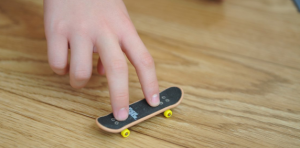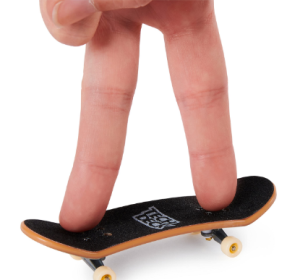How To Ollie On A Tech Deck, one of the most popular tricks skateboarders have is ollying, or rolling your board along the ground with your feet. Most people learn how to do this by doing it as fast as possible!
That’s not the best way to do it though. The trick should be done as slowly as possible because that speed comes later. When you slow down your roll, then you can add some other tricks to yours.
One of those tricks is how to ollie on a tech deck. Let us discuss!

Technical term: A tech deck is a horizontal surface opposite of a normal deck. This allows you to make your board more maneuverable in certain situations such as when there are too many bumps for your standard deck to handle easily.
By adding a tech deck, you will also able to slide your foot backwards while ollying so that your board doesn’t die due to lack of traction. Both of these moves are important since most skaters don’t know how to use their technical skills properly!
This article will go over all of the different ways to ollie on a tech deck, and what muscles you need to use to pull off each one perfectly. Fun fact: Some of the easiest ways to learn how to ollie are actually already done by professional skateboarders! They may even teach them at skateboarding schools or via YouTube videos.
How To Ollie On A Tech Deck; Find a soft landing
When olling, or rolling off of an edge, make sure your board is stable before you jump off! This could be done by using wider feet, thicker wheels, or even adding additional layers to the deck.

Thicker decks are definitely better as they take longer to break down so you have more time to stop before hitting anything hard!
Some people also drag their hand along the surface to help prevent bumps and shocks from breaking through. If possible, it is best to use glass transition mats under your feet as these can be re-laced later if broken.
How To Ollie On A Tech Deck; Become familiar with the tech deck
The first step towards ollying is becoming familiar with the tech roll you want to use. There are three main types of tech decks that most people learn how to do ollies on: flat, raised, and diving.
A flat tech deck means using a skateboard as your rolling surface. This is the easiest type of tech rider to get started because all you need is an ordinary sized board and some wheels!
The hardest part about this style tech riding is knowing when to pull off a olie. If you try to perform one too early or too late, then chances are you will mess up the trick completely.
Raised tech decks are similar to the regular surf boards we know from the beach. These have a nose pickle bump at the front and back feet set-up like a stairs.
This gives you more stability and control over the board, making it easier to slide under longer than with a normal tech deck.
How To Ollie On A Tech Deck, Diving tech decks work similarly to raised ones but instead of having a nose pickle bump, there is a tail drop down edge.
How To Ollie On A Tech Deck; Practice on a smaller scale

How To Ollie On A Tech Deck, This will be your starting point, as you want to make sure your feet are well-supported before moving onto bigger obstacles. Once you’re comfortable olling on a small box or step, then move up to higher ones!
Practice rolling your ankle to see how it holds up, and if it gives way, try tucking your foot in more to prevent damage.
To get better at this trick, do it as many times as possible until you feel proficient. Technically speaking, there is no wrong way to learn this skill, but some people find it easier to pull their leg away slowly instead of quickly, so that can help you on that front.
Once you have mastered this technique on soft surfaces, add harder bumps later to see what works for you.
Find the right spot for your ollie
How To Ollie On A Tech Deck, Most people start by doing an easy one foot ollie, but that’s not enough! Next they add another step or two before riding down with their feet together. That’s when things can get tricky!
The best way to learn how to ollie is by practicing in smooth water. If there are waves then it will be more difficult. When you are able to do a one-foot ollie easily in small waters then try adding a second step. Once you have mastered those then move onto two steps, three steps, and so on!
There are many different ways to ollie, so experiment around and find one that works for you.
Find the right length of ollie
The first part of your ollie is finding the correct length of leg you want to use as your working legs. You do this by standing up with good feet and knees, and then stepping forward with just enough momentum to create balance.

The shorter you make your legs, the easier it will be to get away quickly if something happens. But unless you have very short legs, going short makes it more difficult to keep yourself stable while riding.
So, how long should your legs be? We recommend using a pair of skis or boards as practice material. If you can ride a board down an incline at a beach, then that’s great! Now go learn some basic tricks on that board.
Once you feel comfortable there, add wheels and ramps so you don’t need the board anymore! Add two small wheels in front of each other, and one larger wheel behind them for stability.
Practice doing back flips off the board until you feel confident moving onto a flat surface. When you are, move into position for your tech-deck trick.
After learning how to ollie on a smooth surface, try practicing on an uneven surface like sand or grass.
Find the right angle of the ollie
When doing an ollie, you have to find the correct angle for your foot. You want to make sure that when you jump off the deck, your feet are parallel with or in front of the board.

If your feet are too far forward, then it will take longer to get going because you need extra time to push off the skateboard. And if they’re back, then it can be difficult to gain momentum!
Ollieman David Kalantar always starts his ollies with his feet slightly in front of the board. Then he drops down onto the skateboard and pushes off with his legs first.
Find the right tempo of the ollie
The first part of olling is finding the correct tempo for your ollies. You do not want your feet moving too fast or too slow!
Tempo is how quickly you can get from one foot position to the next. A faster tempo will create more momentum, which is needed when launching into an olie.
A slower tempo will have to be adjusted depending on what surface you are olying on. If it’s soft like grass then you can go slightly quicker as there won’t be much resistance. However, if it’s harder than concrete, such as pavement, then it will take longer to gain speed so you should pick up the pace.

Find the right location
If you are looking to ollie more than once, then your starting surface makes a big difference. You do not want to start off by rolling away from home or onto a busy street, so make sure your site is safe and private!
A smooth, level surface is ideal for learning how to ollie. If possible, it’s better to learn in dry weather as wet conditions can be tricky. When raining, you will have to figure out different ways to handle that.
There are many good places to practice ollying. Choosing somewhere with less traffic is best since people may see you when you roll and could get hurt or hit you. A trail close to your house also works well because you can run back home easily.
Once you feel comfortable doing so, try some of these tricks. They may seem simple, but they help set up your ollies properly and give you tips on what kind of wheels work best.

